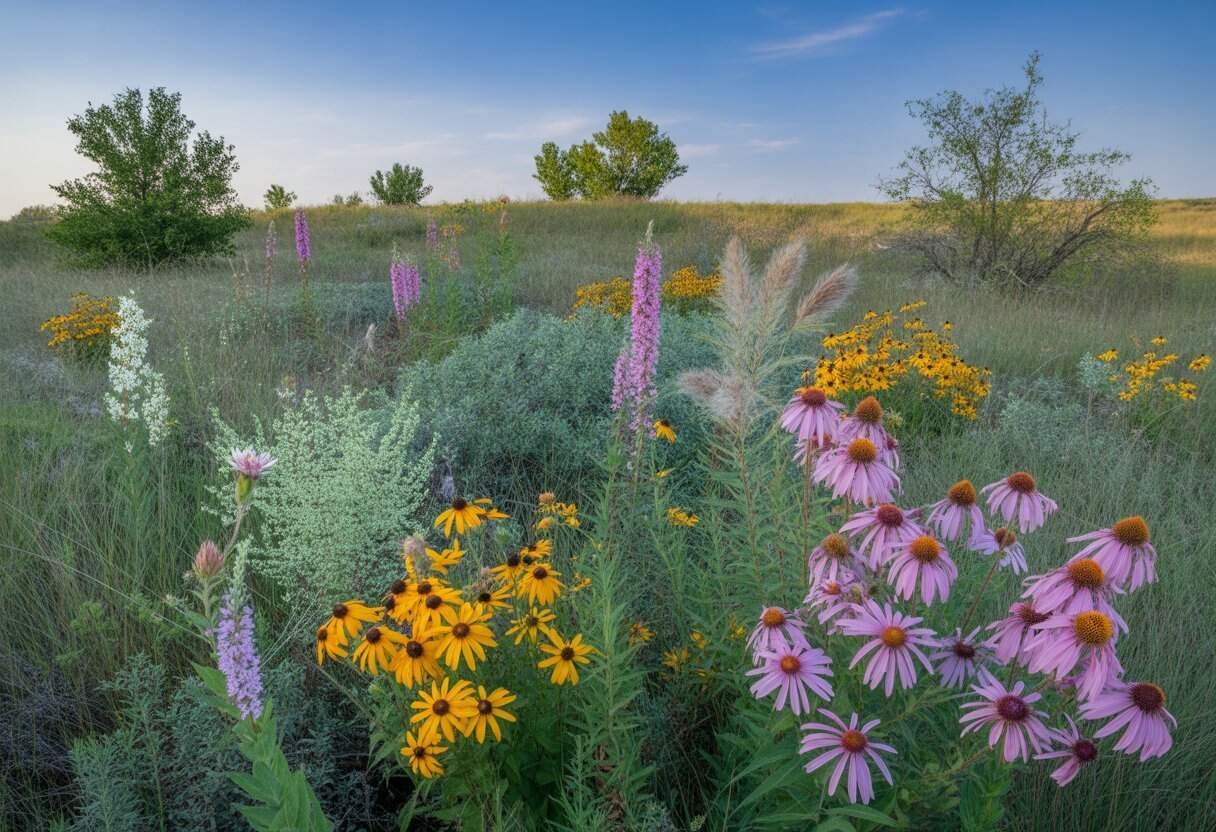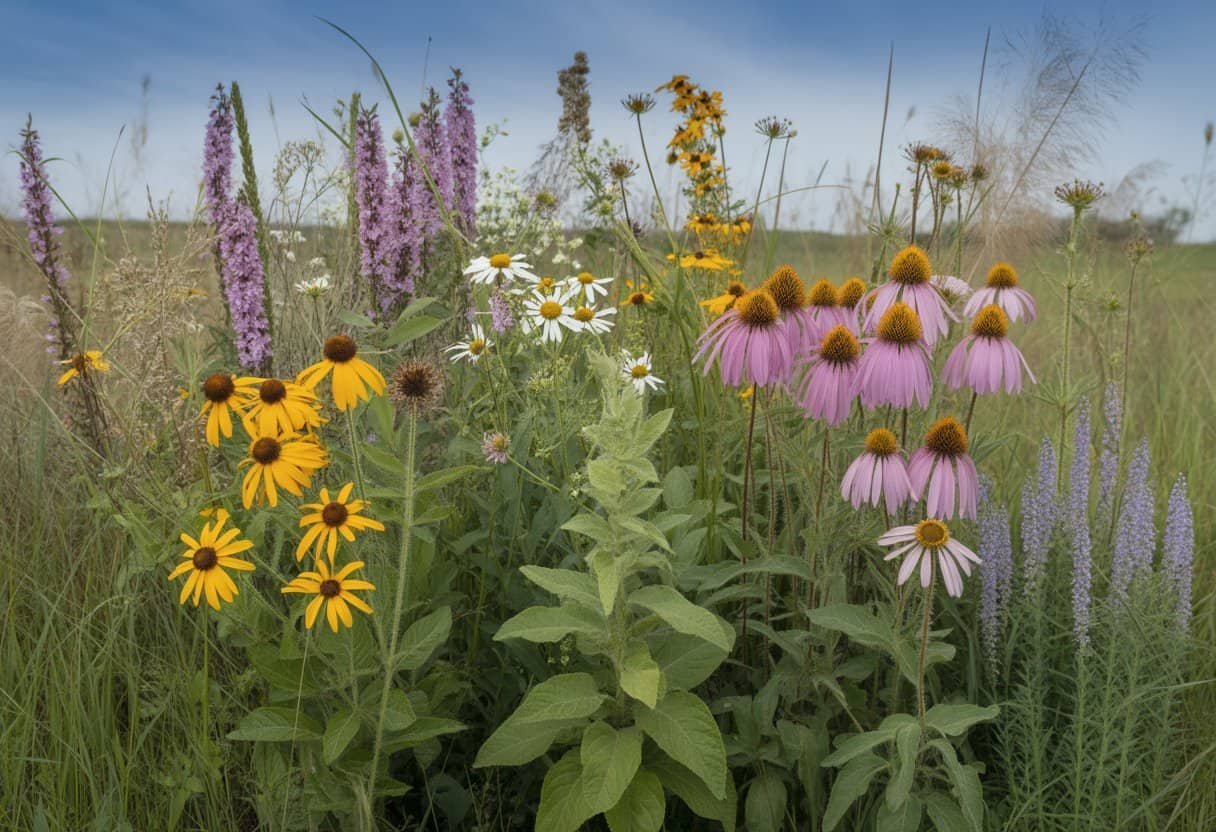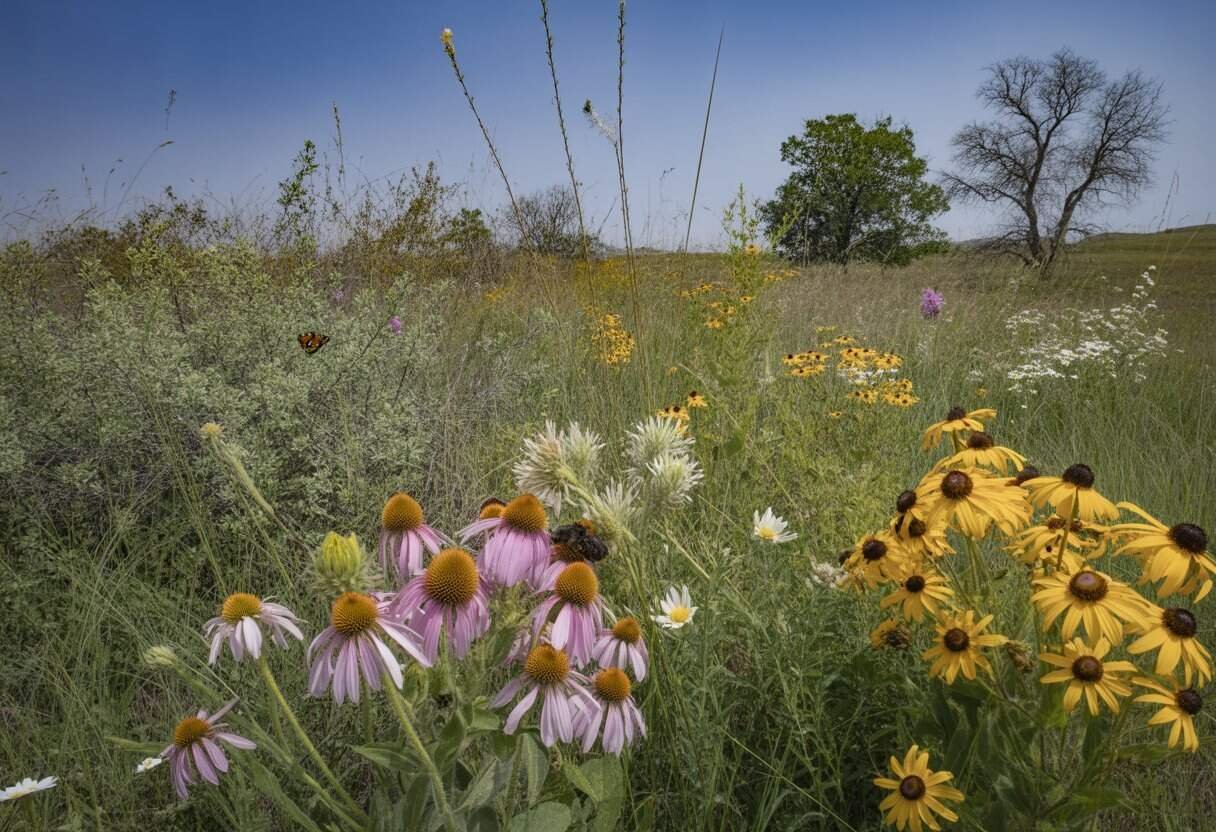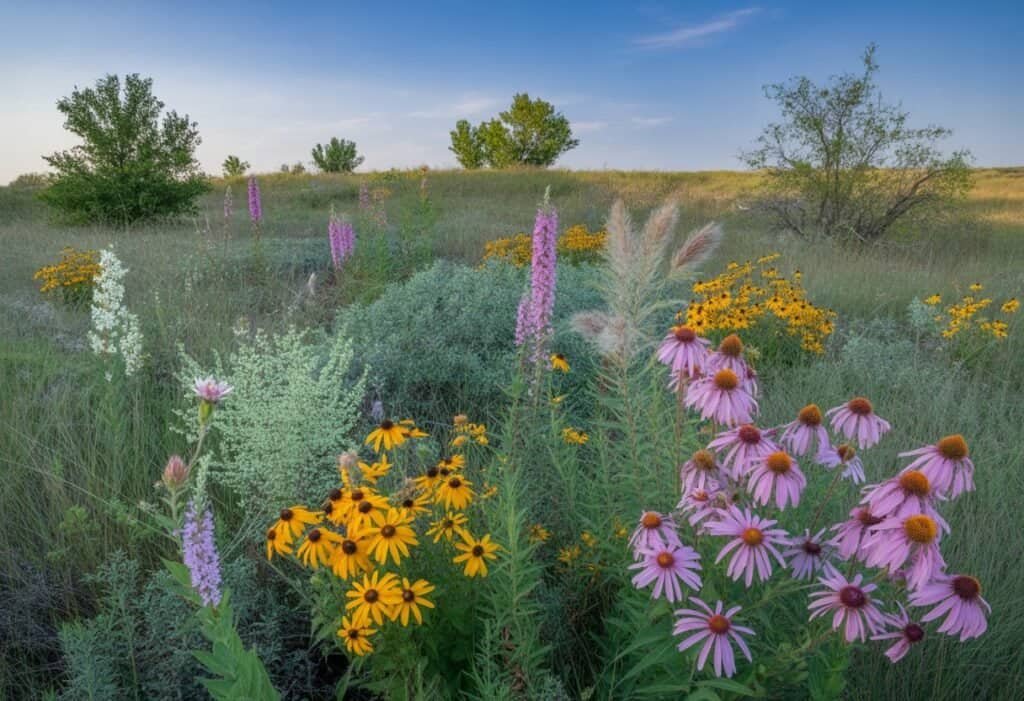Oklahoma is home to a remarkable variety of native plants that have adapted to the state’s diverse landscapes. From the tallgrass prairies in the east to the dry mesas in the west, these plants thrive in local conditions without extra water or care.
Using Oklahoma native plants in your garden saves water, supports local wildlife, and creates an authentic sense of place that connects your landscape to the natural heritage of the region.

Native plants like purple coneflower, Indian blanket, and switchgrass offer beauty throughout the seasons. They require minimal maintenance.
These plants have deep root systems that help them survive Oklahoma’s hot summers and cold winters. They also provide essential habitat and food for pollinators, birds, and other wildlife.
Key Takeaways
- Oklahoma native plants require less water and maintenance while thriving in the state’s climate and soil conditions.
- Native species support local ecosystems by providing food and habitat for pollinators, birds, and other wildlife.
Overview of Oklahoma Native Plants
Oklahoma’s landscape hosts over 2,500 native plant species adapted to the state’s diverse climate and soil conditions. These plants form the backbone of local ecosystems and offer sustainable options for gardens.
What Makes a Plant Native to Oklahoma
Native plants in Oklahoma evolved in the region for thousands of years before European settlement. These plants occur naturally in Oklahoma’s prairies, forests, and wetlands.
They’ve adapted to survive Oklahoma’s challenging conditions, including extreme temperature swings, periodic droughts, and various soil types. Oklahoma’s geographic position creates unique plant communities.
The eastern forests contain different native species than the western shortgrass prairies. Plants like little bluestem grass, purple coneflower, and Oklahoma redbud have traits that help them thrive locally.
Native plants generally require less maintenance once established. Their deep root systems help them access water during dry periods, so they need less irrigation than non-native plants.
Importance of Native Flora
Native plants provide essential food and habitat for local wildlife. Birds, butterflies, and beneficial insects depend on these plants.
For example, monarch butterflies specifically need milkweed plants to complete their life cycle. Using native plants in landscapes conserves water.
Their adaptation to local rainfall patterns means they typically need less supplemental watering than exotic species. Indigenous peoples used many native plants for food, medicine, and crafts.
Plants like echinacea (purple coneflower) and yucca have historical significance for their medicinal and practical uses. These plants also help prevent erosion with their extensive root systems that stabilize soil during heavy rains and floods.
Biodiversity and Ecosystems
Oklahoma’s native plants support complex ecosystems across the state’s varied terrain. From the Cross Timbers forests to tallgrass prairies, these plant communities create interconnected food webs.
Native plant diversity ensures ecosystem resilience. When one species struggles due to weather or disease, others can maintain the ecosystem’s function.
Key Oklahoma ecosystems include:
- Tallgrass prairies with big bluestem and Indian grass
- Cross Timbers woodlands featuring post oak and blackjack oak
- Riparian areas with sycamore and cottonwood trees
- Shortgrass prairies in western regions
Climate change threatens native plant communities. Shifting temperature and precipitation patterns may force some species to migrate northward or face local extinction.
Key Native Plant Species in Oklahoma

Oklahoma’s diverse landscapes support a rich variety of native plants adapted to the state’s unique climate and soil conditions. These native species provide essential habitat for wildlife while requiring less maintenance and water than non-native alternatives.
Native Trees of Oklahoma
The oak family dominates Oklahoma’s woodlands with several important species. Blackjack oak thrives in poor, dry soils and provides valuable wildlife habitat.
Post oak grows alongside blackjack in cross timbers forests and has cross-shaped leaves. Red oak and willow oak add vibrant fall color to eastern forests.
Sycamore trees are easily identified by their mottled, peeling bark and large size. They often grow along waterways.
Cottonwoods also prefer wet areas and serve as important riparian zone trees. Flowering dogwood brightens spring woodlands with white or pink blooms.
Southern catalpa trees produce striking white flowers and long seed pods. The rare American smoke tree offers purple-pink flower clusters that look like puffs of smoke.
Sugar maple trees grow mainly in northeastern Oklahoma. They provide stunning fall color and can produce maple syrup.
Notable Shrubs and Vines
Blackhaw (Viburnum prunifolium) stands out among Oklahoma’s native shrubs with its white spring flowers, edible blue-black fruits, and vibrant fall foliage. This versatile plant attracts pollinators and birds.
Oklahoma rose grows wild throughout the state. This hardy shrub produces fragrant pink flowers and bright red rose hips that persist into winter, providing food for wildlife.
Several native viburnums thrive in Oklahoma’s varied conditions. These shrubs offer spring flowers, summer berries, and fall color.
Sumac varieties add brilliant red fall color and produce berry clusters that feed birds through winter. Coral honeysuckle vine climbs trees naturally and offers tubular red flowers that attract hummingbirds.
Unlike invasive Japanese honeysuckle, this native vine maintains ecological balance.
Significant Grasses and Sedges
Big bluestem, often called “turkey foot” for its distinctive seed heads, once dominated the tallgrass prairie. This grass can reach 6-8 feet tall and turns reddish-copper in fall.
Its deep roots help prevent erosion and build soil. Switchgrass adapts to various conditions and provides excellent wildlife cover.
This grass offers ornamental value with airy seed heads and golden fall color. Little bluestem grows in shorter bunches with blue-green summer foliage that turns rusty-orange in fall.
It thrives in poor soils where other plants struggle. Indian grass complements bluestems in prairie plantings with golden seed heads that catch sunlight.
Together with bluestems, it formed the backbone of Oklahoma’s original prairie ecosystems. Native sedges fill specialized niches in moist areas and provide food and habitat for unique wildlife species.
Essential Wildflowers
Common milkweed plays a crucial role as the primary host plant for monarch butterflies. Its pink flower clusters also attract many beneficial insects.
Oklahoma wild petunia produces lavender trumpet-shaped flowers throughout summer. This drought-tolerant perennial spreads gradually to form attractive colonies.
Narrowleaf bluestar offers star-shaped blue flowers in spring and golden fall foliage. It grows well in both sun and part shade.
Black-eyed Susan brightens summer landscapes with golden-yellow flowers around dark centers. This reliable native reseeds easily in favorable conditions.
Water lily beautifies ponds with floating leaves and elegant flowers. Native varieties support aquatic ecosystems better than exotic alternatives.
Purple coneflower serves as both a stunning garden plant and a wildlife magnet. Its seeds feed birds, while its nectar attracts butterflies and bees.
Benefits of Native Plants for Oklahoma’s Environment

Oklahoma native plants deliver significant environmental advantages while requiring less maintenance than non-native species. These plants have evolved alongside local wildlife and soil conditions for thousands of years, creating natural harmonies that benefit the entire ecosystem.
Supporting Pollinators and Wildlife
Native plants provide essential habitat and food sources for Oklahoma’s pollinators and wildlife. Butterflies like the Oklahoma state butterfly, the black swallowtail, depend on native plants such as butterfly milkweed and purple coneflower.
Bees, including Oklahoma’s 200+ native bee species, collect pollen and nectar from plants like black-eyed Susans and blazing stars. These interactions are crucial for plant reproduction and food production throughout the state.
Birds benefit greatly from native plantings. Cardinals, chickadees, and bluebirds eat insects that live on native plants and consume seeds from plants like sunflowers and elderberries.
Small mammals and beneficial insects also find shelter and food in native plant communities. Even a small native garden can serve as a miniature wildlife refuge in urban areas.
Improving Soil Health
Oklahoma’s native plants improve soil health through their extensive root systems. Some prairie plants develop roots reaching 15 feet deep, while lawn grass roots reach just a few inches.
These deep roots break up compacted soil and allow better water infiltration. Native plants like little bluestem and switchgrass hold soil in place during heavy rains and high winds.
Many native species also support beneficial relationships with soil microorganisms. These relationships improve nutrient cycling and create healthier soil.
Native plants don’t need synthetic fertilizers that can damage soil biology. They’ve adapted to thrive in Oklahoma’s natural soil conditions, whether sandy, clay-based, or rocky.
Water Conservation Advantages
Oklahoma native plants excel at water conservation, which is critical in a state prone to drought. Once established, native plants typically require minimal supplemental watering.
Species like prairie dropseed and Oklahoma redbuds survive with natural rainfall patterns. Their drought tolerance comes from deep roots and specialized leaf structures that reduce water loss.
During rainstorms, native plant landscapes absorb much more water than traditional lawns. This reduces runoff and helps replenish groundwater supplies.
For Oklahoma gardeners, native plants mean lower water bills and less time spent watering. Native plant gardens often need watering only during extreme drought, unlike non-native ornamentals that may require frequent irrigation.
Native Plant Habitats and Regions of Oklahoma
Oklahoma’s diverse landscapes support a rich variety of native plant communities across different ecological regions. The state’s geography creates distinct habitats that influence which plants naturally thrive in each area.
Tallgrass Prairie and Grasslands
The tallgrass prairie once covered much of eastern Oklahoma and represents one of North America’s most endangered ecosystems. Today, only about 4% of the original tallgrass prairie remains.
Big bluestem, indiangrass, switchgrass, and little bluestem form the backbone of these grasslands. These grasses can grow up to 6-8 feet tall in good conditions.
These prairies support over 800 plant species adapted to periodic drought, fire, and grazing. Notable flowering plants include purple coneflower, compass plant, and prairie blazing star.
The soil in these regions contains deep, complex root systems that can extend 15 feet below the surface. This underground network helps prairie plants survive harsh conditions while storing carbon and preventing erosion.
Western Oklahoma features shortgrass and mixed-grass prairies with drought-resistant species like buffalo grass, blue grama, and sideoats grama.
Forests and Woodlands
Oklahoma’s forests vary dramatically from east to west. The eastern third of the state contains oak-hickory and oak-pine forests similar to those found in the eastern United States.
The Ouachita Mountains and Ozark Highlands host diverse tree communities including shortleaf pine, white oak, black oak, and hickory species. The Cross Timbers region forms a transition zone between eastern forests and western grasslands.
Post oak and blackjack oak dominate the Cross Timbers, creating a mosaic of woodland and prairie. These hardy trees survive on rocky, shallow soils where other species struggle.
Along river corridors, bottomland hardwood forests feature species like American elm, green ash, and pecan. These forests provide critical wildlife habitat and help filter water entering streams.
Wetlands and Riparian Zones
Oklahoma’s wetlands and riparian areas create unique habitats for moisture-loving plants. These zones occur along the state’s rivers, streams, and in low-lying areas that collect water.
Common wetland plants include cattails, bulrushes, and water lilies. Along stream banks, willows, cottonwoods, and sycamores form important riparian forests that prevent erosion.
The Red Slough Wildlife Management Area in southeastern Oklahoma contains some of the state’s most extensive wetlands. Here, bald cypress trees create swamp forests similar to those found farther south.
Playa lakes in western Oklahoma fill seasonally. These wetlands support specialized plant communities adapted to alternating wet and dry conditions.
Ephemeral wetlands provide critical habitat for migrating birds and many plant species.
Resources for Identifying Native Species
Finding and identifying Oklahoma’s native plants becomes easier with the right tools and connections. Several excellent resources exist for both beginners and experienced plant enthusiasts throughout the state.
Field Guides and Indexes
The Oklahoma Vascular Plants Database serves as a comprehensive index of native species with detailed photographs and identification keys. This resource catalogs over 2,500 species found within state boundaries.
“Field Guide to Oklahoma Plants” by Ronald J. Tyrl is particularly useful for on-site identification with its waterproof pages and regional organization. It includes clear illustrations and distinctive characteristics for each plant.
The Oklahoma Biological Survey publishes updated plant indexes every few years, available both online and in print. Their mobile app lets users search by visual characteristics like flower color, leaf shape, and habitat.
Digital resources like iNaturalist and the Oklahoma Plant Atlas offer location-specific searches and community-verified identifications. These tools help pinpoint which species grow in specific counties or ecosystems.
Local Research and Networks
The Oklahoma Native Plant Society hosts monthly meetings and seasonal field trips led by botanical experts. Their quarterly newsletter features identification tips and highlights newly documented species.
University extension offices provide free plant identification services and maintain local specimen collections. Oklahoma State University’s herbarium holds over 140,000 preserved samples for reference and research.
Master Naturalist programs throughout Oklahoma train volunteers to identify native plants. These programs connect beginners with knowledgeable mentors who share practical identification techniques.
Local conservation organizations like The Nature Conservancy maintain demonstration gardens with labeled native plants. These living collections help people recognize species in their natural growth patterns and seasonal changes.
How to Incorporate Native Plants Into Oklahoma Gardens
Adding Oklahoma native plants to your garden creates a beautiful landscape that thrives naturally in the local climate. Native plants support local wildlife while requiring less water and maintenance than non-native species.
Choosing the Right Plants for Your Landscape
Start by assessing your garden’s conditions. Note how much sun your space receives and what type of soil you have.
Clay soils are common in Oklahoma, so plants that tolerate these conditions work well.
For sunny areas, consider:
- Black-eyed Susan
- Purple coneflower
- Butterfly milkweed
- Little bluestem grass
For shady spots, try:
- Wild columbine
- Solomon’s seal
- Oak sedge
- Wild ginger
Match plants to your specific growing zone. Oklahoma spans zones 6a-7b, so check which plants thrive in your region.
Consider the mature size of plants when selecting them. Some prairie grasses reach 6 feet tall, while ground covers stay under 6 inches.
Design Tips for Native Plant Gardens
Group plants with similar water and light needs together. This practice, called hydrozoning, makes maintenance more efficient.
Create visual interest by varying heights. Place taller plants like Joe Pye weed or switchgrass toward the back of borders, with mid-height plants in the middle and ground covers in front.
Use native plants in traditional garden styles. Oklahoma natives work in formal gardens, cottage gardens, or prairie-style landscapes.
Add structural elements like stone paths or benches to create a sense of order. These features provide contrast to the informal look of native plantings.
Plant in drifts or clusters rather than single specimens. Groups of 3-7 plants of the same species create more visual impact.
Maintenance and Care of Native Species
Water new plants regularly until established, usually for the first growing season. After that, most native plants need minimal supplemental water except during severe drought.
Avoid excessive fertilization. Most Oklahoma natives evolved in lean soils and don’t require rich nutrients.
Too much fertilizer can cause floppy growth and fewer flowers.
Leave seed heads and stems standing through winter. They provide food and shelter for birds and add winter interest to the garden.
Divide spring-blooming perennials in fall and fall-blooming perennials in spring. This keeps plants vigorous and gives you extras to expand your garden.
Use mulch to suppress weeds and retain moisture. A 2-3 inch layer of shredded leaves, pine straw, or wood chips works well for most native gardens.
Conservation and Future Outlook for Oklahoma Native Plants
Oklahoma’s native plants face challenges from development, invasive species, and climate change. Organizations, communities, and individuals must work together to protect these valuable ecological resources.
Current Conservation Efforts
The Oklahoma Native Plant Society leads many preservation initiatives across the state. They identify threatened plant species and establish protected areas where native plants can thrive.
Several state parks and wildlife refuges serve as sanctuaries for native vegetation. The Tallgrass Prairie Preserve, spanning nearly 40,000 acres, stands as one of the most successful conservation projects in Oklahoma.
Government agencies partner with conservation groups to restore degraded habitats. These projects often involve removing invasive species and replanting areas with appropriate native vegetation.
The Oklahoma Biological Survey monitors plant populations and tracks changes in distribution patterns. This scientific data guides conservation priorities and helps measure the success of programs.
Community Engagement and Education
Public education forms the backbone of effective conservation. Workshops teach gardeners how to use native plants in their landscapes, reducing water usage and supporting local ecosystems.
School programs introduce students to Oklahoma’s plant heritage. Field trips to natural areas help children appreciate native vegetation and understand its importance.
Demonstration gardens at public facilities showcase the beauty and practicality of native plants. These living examples inspire visitors to grow native species at home.
Social media campaigns spread awareness about the benefits of native plants. Online plant identification groups help people learn about the species growing in their neighborhoods.
Protecting Biodiversity for Future Generations
Climate change brings new challenges for Oklahoma’s native plants. Conservation strategies now include creating habitat corridors to allow plant populations to migrate as conditions change.
Seed banks preserve genetic diversity for rare and threatened species. These collections provide insurance against extinction and material for future restoration.
Researchers develop drought-resistant native varieties to help gardeners and farmers adapt to changing conditions. Plants that evolved in Oklahoma’s variable climate often show remarkable resilience.
Responsible land management practices protect existing plant communities. Techniques like prescribed burning mimic natural processes and maintain healthy ecosystems for native plants.
Community science projects engage citizens in monitoring plant populations. This expanded network of observers helps track changes and identify areas needing protection.
Frequently Asked Questions
Oklahoma gardeners often wonder about selecting and maintaining native plants for their landscapes. These plants offer beauty and environmental benefits while being adapted to local conditions.
What are some common native plants used for landscaping in Oklahoma?
Oklahoma’s landscapes benefit from plants like Purple Coneflower (Echinacea purpurea), which produces stunning purple blooms that attract butterflies. This prairie native thrives in full sun and tolerates drought once established.
Black-eyed Susan (Rudbeckia hirta) offers bright yellow flowers with dark centers that bloom from June through October. These hardy perennials require minimal care and reseed readily.
Oklahoma’s state wildflower, Indian Blanket (Gaillardia pulchella), displays red and yellow daisy-like blooms from May until frost. It performs well in poor soils and hot, dry conditions.
How can one identify native plant species in Oklahoma?
Native plants often have deep root systems or waxy leaf coatings that reduce water loss. These features help plants survive seasonal drought conditions.
Field guides specific to Oklahoma flora provide detailed descriptions and photographs for identification. The Oklahoma Native Plant Society offers resources with regional plant information.
Plant databases from Oklahoma State University Extension include search features for identifying native species by characteristics like flower color, bloom time, and growing conditions.
Where can I purchase native Oklahoma plants?
Local nurseries specializing in native plants operate throughout Oklahoma, especially near Oklahoma City and Tulsa. These businesses often provide expert advice on plant selection and care.
The Oklahoma Native Plant Society hosts annual plant sales in spring, offering a variety of locally grown native species. These events usually take place in April and May.
Several mail-order nurseries specialize in Oklahoma and Great Plains native plants, shipping throughout the year. Their catalogs frequently include detailed growing information for each species.
Which low maintenance native plants are recommended for Oklahoma landscaping?
Little Bluestem (Schizachyrium scoparium) grass requires almost no maintenance once established. Its blue-green summer foliage turns copper-red in fall, providing year-round interest.
Butterfly Milkweed (Asclepias tuberosa) thrives in Oklahoma’s hot summers with minimal water. Its bright orange blooms attract monarch butterflies and other pollinators from June through August.
Prairie Dropseed (Sporobolus heterolepis) forms neat clumps of fine-textured foliage. This drought-tolerant grass needs no supplemental watering after establishment and rarely requires division.
What native trees are specific to the Oklahoma region?
Eastern Redbud (Cercis canadensis) produces striking pink-purple flowers in early spring before its heart-shaped leaves emerge. This understory tree reaches 20-30 feet tall at maturity.
Oklahoma’s state tree, the Eastern Redbud, adapts to various soil conditions and provides early season food for pollinators. Its seedpods persist through winter, adding visual interest.
Blackjack Oak (Quercus marilandica) thrives in Oklahoma’s challenging soils and climate extremes. This drought-tolerant tree grows 20-40 feet tall with distinctive leaf shapes.
Can you provide a list of native shrubs suitable for Oklahoma’s climate?
American Beautyberry (Callicarpa americana) produces clusters of striking purple berries that last into winter. This shrub grows 3-5 feet tall, thrives in partial shade, and attracts birds.
Fragrant Sumac (Rhus aromatica) offers spring flowers and summer berries. In fall, its leaves turn bright colors. This adaptable shrub grows 2-6 feet tall and tolerates poor soils.
Aromatic Aster (Symphyotrichum oblongifolium) displays masses of blue-purple flowers in fall. This woody-based perennial reaches 2-3 feet tall and survives drought.


